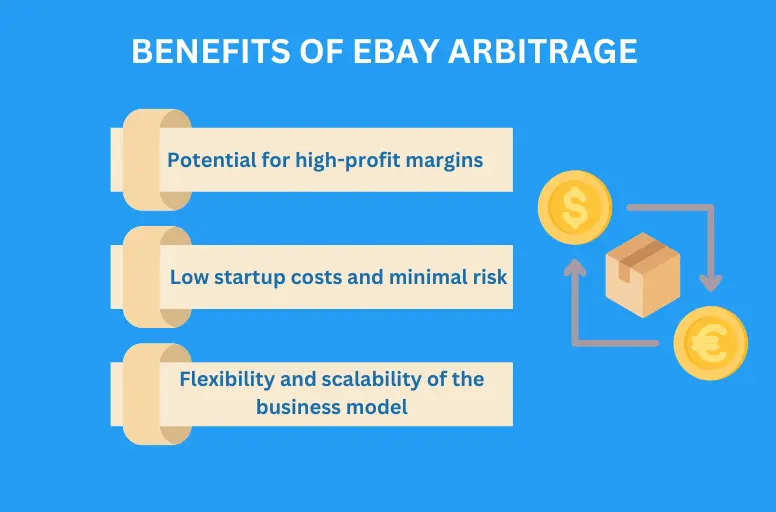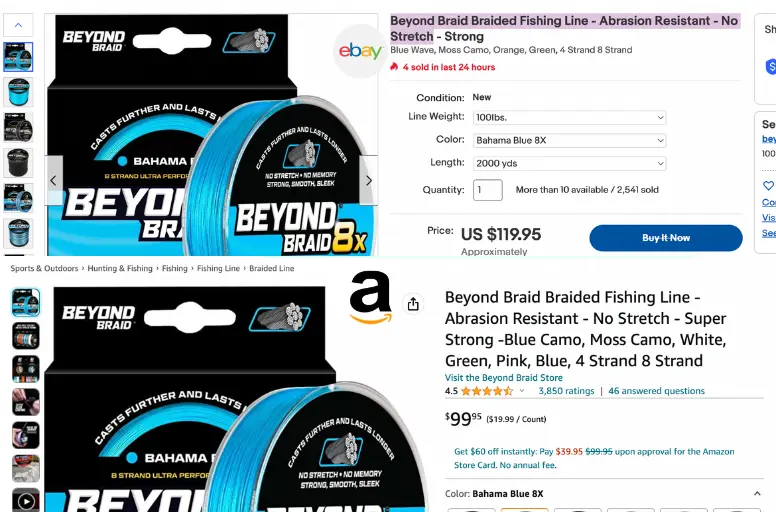Are you seeking a method to generate income online without the need for inventory investment or shipping hassles? If so, you might want to consider eBay retail arbitrage. So, what is retail arbitrage, and what is eBay arbitrage? Retail arbitrage is a method of buying products at a low price on one site and selling them at a higher price on another site.
Similarly, eBay arbitrage involves purchasing items from other platforms, such as Amazon, at a lower cost and then selling them on eBay. By leveraging the price disparities of eBay Amazon arbitrage and the vast customer base of these two best selling platforms, you can generate profits while leaving the fulfillment to the original website.
In this article, we will explain everything related to retail arbitrage on eBay, including:
- Benefits of eBay arbitrage
- How to get started with eBay arbitrage
- eBay retail arbitrage: Best practices
From understanding the fundamentals to mastering the art of sourcing and pricing, we’ve got you covered. So, let’s dive in and unlock the secrets of eBay arbitrage!
Benefits of eBay Arbitrage
eBay offers a powerful online marketplace for selling products with global reach and convenient selling features. So, online sellers can leverage the benefits of eBay store to do eBay arbitrage. Why should you do eBay retail arbitrage? Below are some of the main benefits for eBay arbitrageurs:
1. Potential for high-profit margins
The potential for high-profit margins in retail arbitrage eBay arises from exploiting price discrepancies. Sellers can purchase products at a lower cost from one source and resell them on eBay at a higher price, creating a significant margin. This profit potential is enhanced by identifying niche or in-demand and top-selling items on eBay. Effective pricing strategies, market research, and competitor analysis help set competitive prices while maintaining healthy profit margins. However, it’s important to monitor market trends and adapt strategies to sustain profitability continuously.
2. Low startup costs and minimal risk
Compared to many other eBay business ideas, eBay online arbitrage requires relatively low initial investments. Sellers can start with a small amount of capital, as they primarily focus on sourcing products at discounted prices, such as clearance sales, liquidation auctions, or discounted inventory. By engaging in eBay arbitrage, individuals with limited financial resources can easily enter the market and embark on their entrepreneurial journey.
Plus, eBay arbitrage poses minimal risk compared to traditional business models. Since sellers do not have to invest heavily in manufacturing, inventory, or a physical storefront, they are not exposed to significant financial risks.
Speaking of eBay business ideas, don’t skip eBay dropshipping. That could be your perfect business model if you don’t want to handle inventory on this marketplace.
3. Flexibility and scalability of the business model
In terms of flexibility, sellers have the freedom to choose their own working hours, allowing them to fit their business around other commitments. They can also adapt their strategies based on market trends, experiment with different product categories, and adjust pricing to maximize profitability.
Additionally, eBay online retail arbitrage is a scalable model. As sellers gain experience and establish reliable sourcing channels, they can expand their operations by:
- Sourcing larger quantities of inventory;
- Diversifying their product offerings;
- Exploring additional marketplaces beyond eBay.
The ability to scale globally further enhances the potential for growth. This flexibility and scalability make eBay arbitrage an appealing option for sellers looking for a dynamic and adaptable business opportunity.

How to Get Started with eBay Arbitrage?
If you’re eager to explore the realm of eBay arbitrage and tap into the vast potential of eCommerce, this comprehensive guide is your ultimate starting point. We will guide you through the crucial steps to kickstart your journey with confidence and achieve success in this lucrative venture.
Step 1: Research profitable product categories
To get started, it’s important to identify high-demand products on eBay with a good profit margin. Utilize a retail arbitrage app like Algopix or Profit Scraper to analyze the market and discover the best selling items on eBay. Consider the following factors when evaluating potential products:
- The average selling price and profit margin on eBay
- The competition and sales volume on eBay
- The availability and cost of the product on other marketplaces
- The shipping time and fees from other marketplaces to your customers
It would help if you aimed for products with high demand and low competition on eBay but are cheaper and readily available on other marketplaces like Amazon or Walmart. You can save time for finding the best retail arbitrage items by checking what sells best on eBay.

Step 2: Find profitable deals on eBay
Once you have identified the profitable product categories, the next step is to find the best retail arbitrage items that you can purchase at a low price and sell at a higher price on eBay. Utilize the same tools mentioned earlier to scan thousands of listings in other marketplaces. Those tools also allow you to compare prices and identify potential opportunities for profitable arbitrage.
Let’s use some of the following tricks to find hidden gems that other sellers might miss:
- Searching for misspelled keywords or titles: Many sellers make spelling mistakes or typos when listing their items on eBay. By intentionally searching for these misspelled keywords or titles, you can uncover listings that others might not find.
- Searching for products with poor-quality images or descriptions: Some sellers may not invest the time or effort to create high-quality listings with appealing images or detailed descriptions. These listings are often overlooked by buyers, resulting in potentially lower prices.
- Searching for products that are ending soon or have low bids: Items that are close to the end of their auction or have received few bids may present opportunities for profitable deals. Many buyers tend to focus on auctions that still have a significant amount of time remaining or those with high bidding activity.
You’d better look for products that have a significant price difference between eBay and other marketplaces, enough to cover all the fees and costs involved and still leave you with a decent profit.
Step 3: Create effective product listings
The next step is to create compelling product listings on eBay that will attract buyers and generate sales. You can use the existing listings on the other marketplace as a reference, but you should also make some improvements to stand out from the crowd, such as:
- Using clear and catchy titles with relevant keywords
- Using high-quality images that showcase the product features and benefits
- Using detailed and accurate descriptions that answer common questions and address potential objections
- Using competitive pricing strategies that match or beat your competitors
- Offering fast and free shipping options that appeal to your customers
- Providing excellent customer service and communication that builds trust and loyalty

Don’t forget to monitor your listings regularly and optimize them based on the performance data and feedback. You should test different variables such as titles, images, prices, shipping methods, etc. and see what works best for your products.
Step 4: Evaluate and calculate potential profits
For new or like-new items, you have a couple of options to determine their value and evaluate profit. One approach is to search online stores and get an estimate of their prices. Alternatively, you can check past listings on eBay for similar items to gauge their historical costs.
Assessing used products can be more challenging. Before selling, carefully evaluate their condition and determine a fair price. Consider factors such as imperfections, rarity, and functionality to make an informed decision.
When setting the prices, take into account both competition and demand. It’s crucial to price your items competitively while also considering associated costs like:
- The products’s prices on the other marketplaces
- The shipping cost from the other marketplace to your customer
- The eBay fees, including listing, final value, and PayPal fees
- The taxes, customs, or duties that might apply
- The returns or refunds that might occur
You should also take into account the risks involved in eBay arbitrage, such as:
- The price fluctuations on both marketplaces
- The stock availability on the other marketplace
- The policy violations or account suspensions on either marketplace
Read more: how to start an Amazon FBA businessto boost your Amazon income.
eBay Retail Arbitrage: Best Practices
In this section, we’ll delve into the world of best practices for eBay arbitrage. Here, we have listed the key strategies and proven methods that can elevate your success in the realm of retail arbitrage on eBay. Get ready to unlock the secrets to effectively navigating the world of eBay retail arbitrage and taking your online business to new heights.
1. Conduct price comparison and market analysis
When it comes to eBay arbitrage, conducting price comparisons and market analysis is a crucial step for success. Doing so lets you identify the right online arbitrage sourcing for eBay the prices you list your products for.
Start by comparing prices on different online stores to get an idea of the average market value for a particular product. Additionally, explore completed listings on eBay to see how similar items have been priced and sold in the past.
This evaluation will assist you in establishing competitive pricing that achieves optimal levels of profitability while also appealing to your customers. By staying informed about market trends and adjusting your pricing strategy accordingly, you can maximize your chances of making profitable sales in the world of eBay arbitrage.
Let’s aim for products that have a high demand and low competition on eBay, but are cheaper and easily available on retail stores like Amazon, Walmart, Target or Costco.

2. Employ efficient sourcing and inventory management
Efficient sourcing and inventory management are essential aspects of successful eBay retail arbitrage. To optimize your sourcing process:
- Focus on finding reliable suppliers, wholesalers, or clearance sales that offer products at competitive prices.
- Look for items with high demand and profit potential, ensuring that you can acquire them in sufficient quantities to meet customers’ needs.
- Establish a streamlined inventory management system to keep track of your stock levels, sales, and restocking needs.
- Utilize inventory management tools or software to stay organized and avoid overselling or stockouts.
By sourcing products and managing your inventory efficiently, you can maintain a steady supply of items, minimize costs, and maximize your profitability in eBay arbitrage.
3. Optimize product listings for maximum visibility
To enhance visibility and draw potential buyers’ attention to eBay, optimizing your product listings is essential. Here are some tips to help you optimize your product listings:
Use relevant keywords: Start by conducting keyword research to identify popular and relevant search terms related to your products. Incorporate these keywords strategically in your listing title, description, and product attributes to improve search rankings.
Provide insightful descriptions: Write compelling and informative descriptions highlighting the product’s benefits and unique selling points. Utilize bullet points to create descriptions that are easy to read and scan.
Use high-quality images: Use high-quality images that show the items from different angles.
Offer competitive pricing: Research the pricing of similar products on eBay and offer a competitive price. Try offering free shipping or a discount on multiple purchases to attract buyers. If you wonder how to offer free delivery for sellers, learn more by reading our article about how to ship on eBay.
Use eBay’s Best Match algorithm: eBay’s Best Match algorithm determines which listings are shown first in search results. To optimize your listing for Best Match, make sure you have a high feedback rating, offer competitive pricing, and provide excellent customer service.
4. Implement effective pricing and competitive positioning
Implementing effective pricing and competitive positioning strategies is essential for success in eBay arbitrage. Here are some key considerations for your reference:
For strategic pricing:
- Research the market: Conduct thorough research on eBay and other marketplaces to determine the going rate for your selling products.
- Determine your total costs: Determine your total costs, including the product cost, shipping, fees, and any other expenses. Make sure you factor in all costs when setting your prices.
- Set competitive prices: Set your prices competitively based on your research and costs. Avoid pricing too high or too low. If your price is too high, you’re unlikely to make a sale; if it’s too low, you may not make a profit. Consider the competition condition of the product and adjust your prices accordingly.
- Implement efficient price for bidding listing: Start your auction at a low price to attract bidders. A low starting price can create interest and encourage bidding. Consider setting a reserve price if you’re concerned about selling your item too cheaply. A reserve price is the minimum price you’re willing to accept for the item, and if the bidding doesn’t reach that price, the item won’t sell. This can help you avoid selling your item for less than its worth.
- Utilize pricing tools: Take advantage of pricing tools and software available for eBay sellers. These tools can help automate price adjustments based on market conditions and competitor pricing, allowing you to stay competitive and maximize profits.
For competitive positioning:
Highlight unique selling points: Showcase the unique features, benefits, and value propositions of your products in your listings. Differentiate yourself from competitors by highlighting what makes your offerings special and appealing to buyers.
Offer competitive shipping options: Consider offering free shipping or expedited delivery to attract more buyers. Fast and affordable shipping can give you a competitive edge in the marketplace.
Leverage promotions and discounts: Utilize eBay’s promotional tools to run sales, discounts, or bundle offers. These promotions can attract more customers and incentivize them to choose your listings over competitors.
eBay Arbitrage: FAQs
- Is it legal to buy from Amazon and sell on eBay?
The short answer is yes. It is legal to do Amazon to eBay arbitrage. However, there are some things you need to be aware of and follow to avoid any trouble:
- Don’t violate any trademarks or copyrights of the products you are selling.
- Comply with the terms and conditions of both platforms and respect their policies regarding returns, refunds, customer service, etc.
- Adhere to all relevant laws and regulations concerning sales tax and product safety.
Learn more about these two marketplaces with our blog about Amazon vs eBay comparison.
- Can I use dropshipping as a method for eBay Arbitrage?
Yes, you can. Dropshipping is a common method for eBay Arbitrage, where you don’t have to handle the products yourself. Instead, you order them from the original site and have them shipped directly to your buyers. In doing so, you conserve both time and money on inventory and shipping expenditures.
However, you should note that dropshipping can be risky. This is because you have less control over the shipping process and product quality. Additionally, eBay has specific policies around dropshipping, including requirements for providing tracking information to buyers and making sure the product is shipped within the estimated delivery window.
- What are some common mistakes to avoid in eBay Arbitrage?
eBay arbitrage can be a profitable and easy way to make money online. However, it also requires research and planning. Below are some common mistakes to avoid if you want to succeed in eBay arbitrage:
- Not doing enough market research
- Not optimizing your listings
- Not providing good customer service
Conclusion
In conclusion, eBay arbitrage offers a lucrative opportunity for sellers to profit from the vast marketplace and the ever-growing demand for unique and affordable products. By leveraging strategic sourcing, effective pricing, competitive positioning, and optimized listings, sellers can maximize their visibility and attract potential buyers. However, success in eBay arbitrage requires continuous learning, adaptability, and staying informed about market trends.
We hope this article has provided you with valuable insights and practical tips to embark on your online retail arbitrage journey. To stay updated with the latest news, trends, and strategies in the world of ecommerce, let’s follow our Retailers blog and join our community for sellers. By staying connected with LitCommerce, you can access valuable resources, engage in discussions, and network with like-minded individuals. Join us today, and let’s shape the future of online selling together!



